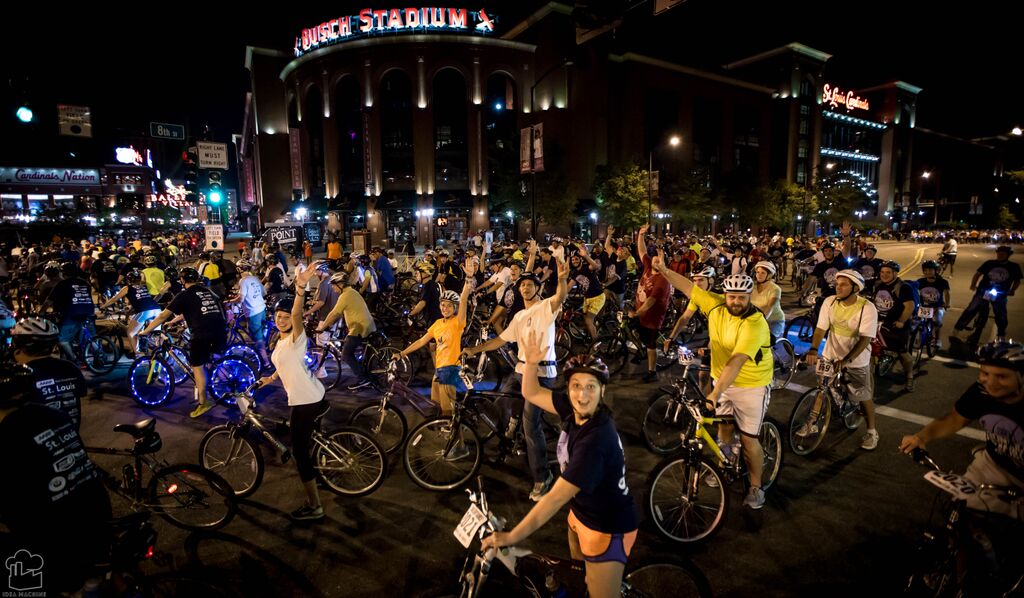It’s not unusual nowadays for a big city to host a bike race that involves binge-eating donuts or a moonlight ride that draws thousands of people. But that wasn’t always the case. Trends have to start someplace, and in this case, that someplace is St. Louis. Here’s a brief look at five outdoor phenomena that began in and around the Gateway City and went on to national — even international — acclaim.
Ghost Bikes

Patrick Van Der Tuin, currently the executive director of St. Louis BWorks, was in his 20s when he sparked a bicycling awareness campaign that has spread across the country.
After seeing a motorist strike a cyclist in a bike lane on Holly Hills Boulevard, Van Der Tuin placed a white-painted bicycle on the spot with a sign reading “Cyclist Struck Here.” Noticing the effect this had on motorists in the area, he then enlisted the help of friends to place 15 more “ghost bikes” in prominent spots around St. Louis where cyclists had been hit by automobiles.
Apart from being a memorial, the bikes were intended as a reminder to passing motorists to share the road. Similar projects have arisen in Pittsburgh, New York City, Albuquerque, Toronto and London.
Tour de Donut

This 30-mile bicycle race held in Staunton, Ill., began with 25 participants in 1988 and now registers more than 1,000 competitors annually. The event was originated by the Mid-America Bicycle Club and inherited by the Boeing Employee Bicycle Club.
The Tour de Donut is traditionally held on the second Saturday in July, to coincide with the Tour de France, which it spoofs. During the race, riders must stop at two checkpoints where they can earn a 5-minute time credit for each donut they eat. Consumption is not mandatory, but encouraged.
Like-minded races have turned up in Ohio, Texas and California. To freshen the program this year, the first ever Tour de Donut Hole will offer a ride of 12 miles with just one donut station.
Moonlight Ramble

In 1964, Dick Leary, a ride leader for the Ozark Area Council of American Youth Hostels, organized a midnight bicycle spin starting at St. Louis Union Station. Only no one else showed up, so Leary rode by himself.
He tried again the next year, and a few people joined him. Even more came the following year. Within a decade, the ride was attracting thousands of participants — and inspiring similar nocturnal outings from Houston to Key West.
Over the years, the St. Louis event has started from different locations, at different times, and taken different routes. Entertainment, vendors, food and VIP-level amenities have been added. Yet nothing has changed the family appeal of the leisurely nighttime ride, a touchstone for generations of area cyclists.
Airplane Skydiving

Albert Berry became the world’s first modern parachutist when he successfully jumped from an airplane 1,500 feet above St. Louis’ army base at Jefferson Barracks in 1912.
People had made parachute jumps before, mostly from balloons, but this was the first from an aircraft. (A Benoit pusher biplane, to be precise.) Berry used a 36-foot diameter chute stuffed in a metal canister attached to the underside of the plane. When he dropped, his weight released the chute and he floated down seated on a trapeze bar.
A competing report says a man named Grant Morton became the first to jump from an airplane a year earlier in California. Call us biased, but we’re going to back Berry’s claim.
American Olympics

In addition to the World’s Fair, St. Louis in 1904 hosted the first ever Olympics held in America. Regrettably, history tells us the games are remembered for their many blunders rather than their glory.
Only 12 countries participated in the Olympics, which dragged on for a grueling 146 days and included tug-of-war as part of the track and field competition. Women only participated in one official event (archery) and so-called “uncivilized tribes” were relegated to a side-contest.
The marathon was held on a dust-covered road in 90-degree heat, forcing 18 of the 32 competitors to drop out. The first man to cross the finish line had ridden in a car for much of the way, and the real winner, Thomas Hicks, was in such agony that his trainers practically carried him across the finish line.
Author: Brad Kovach is the editor/publisher of Terrain magazine.


Leave A Comment